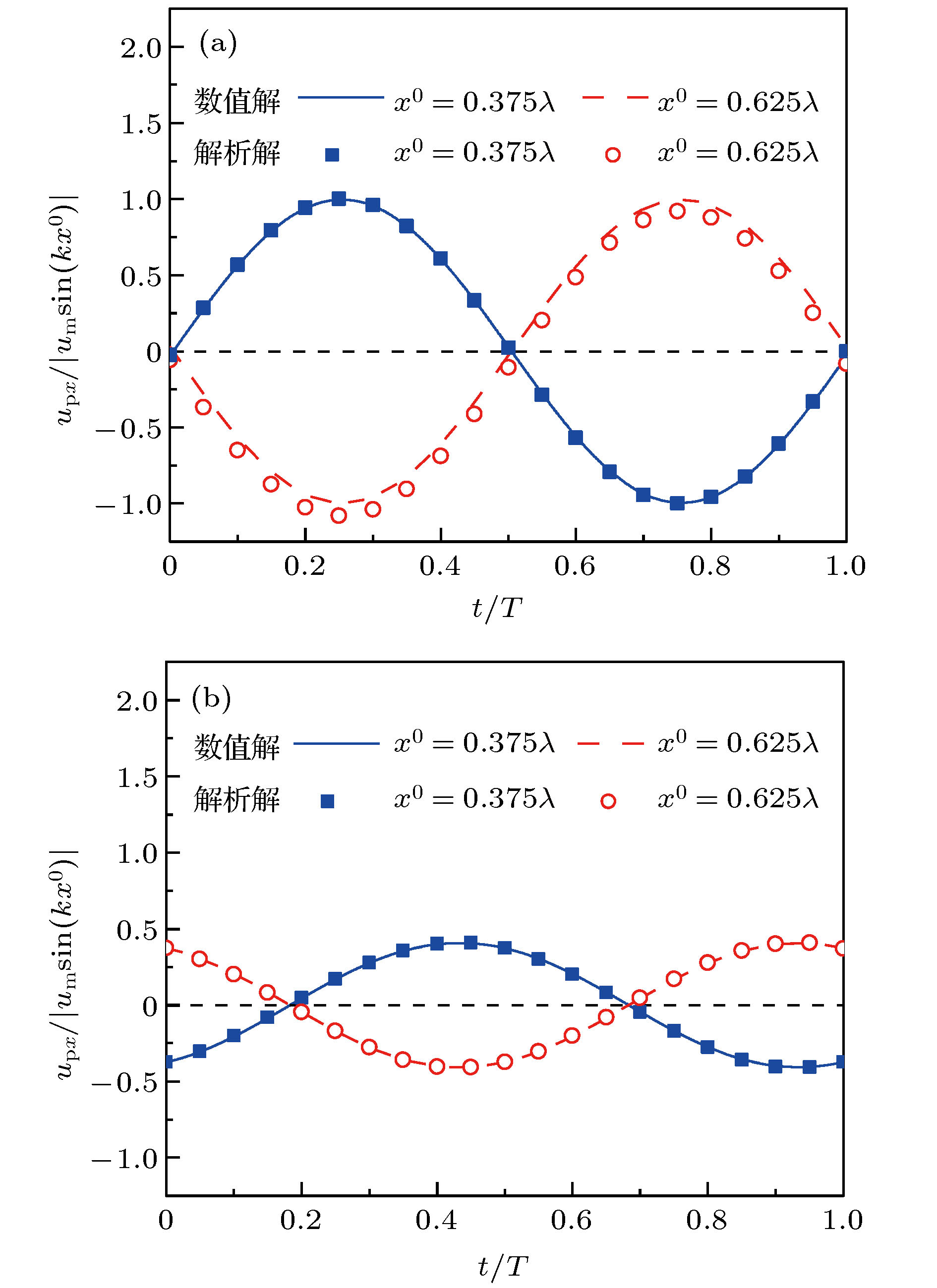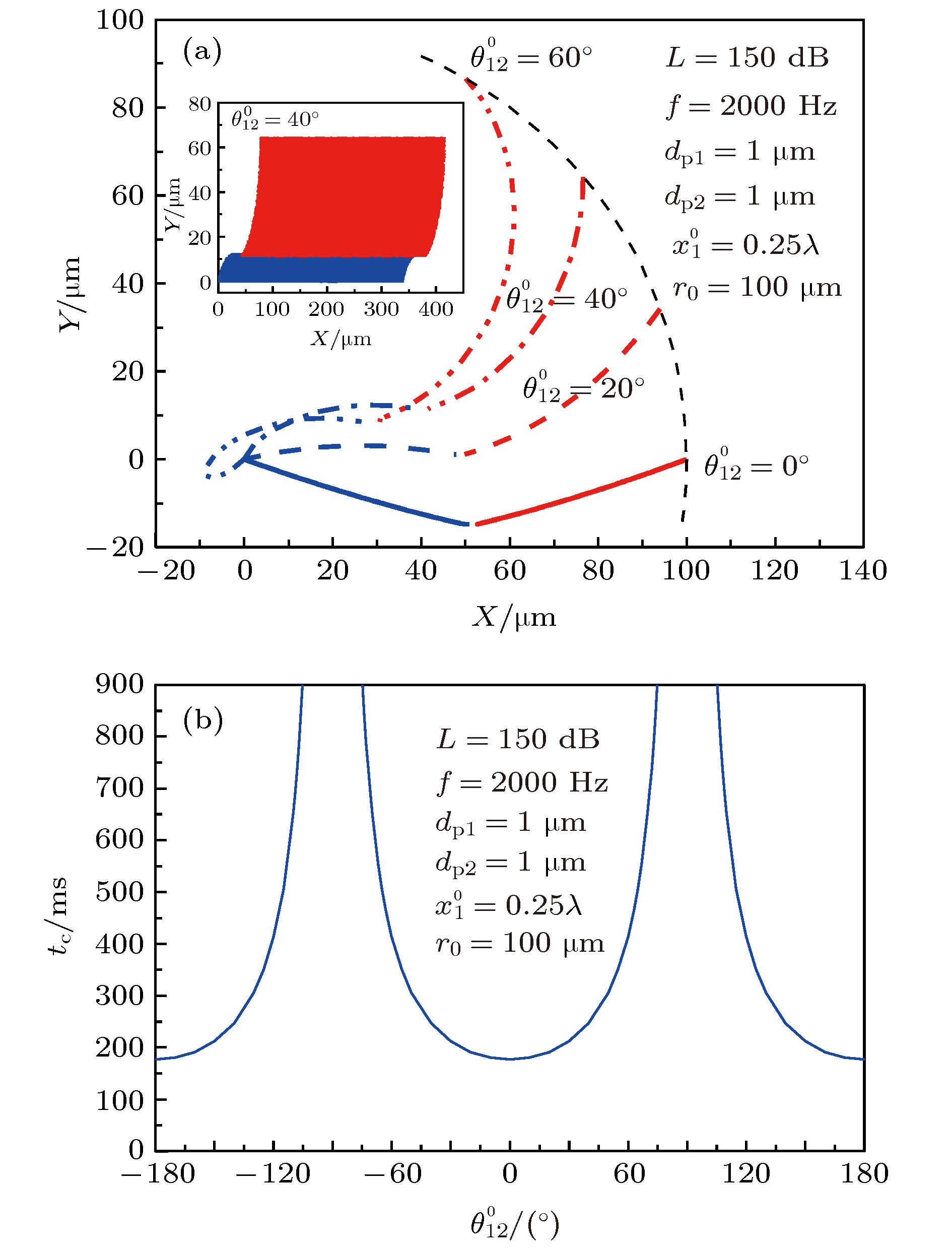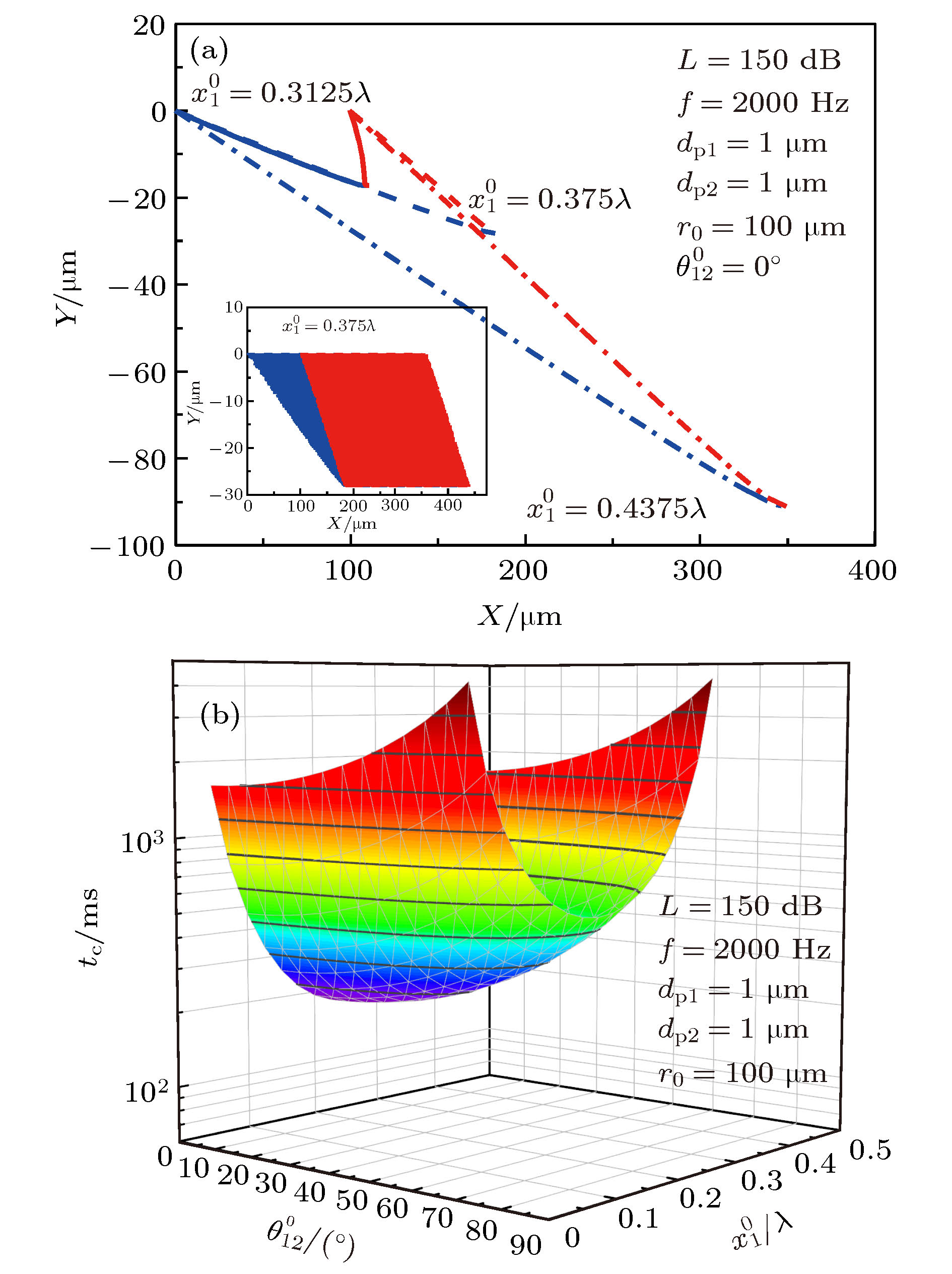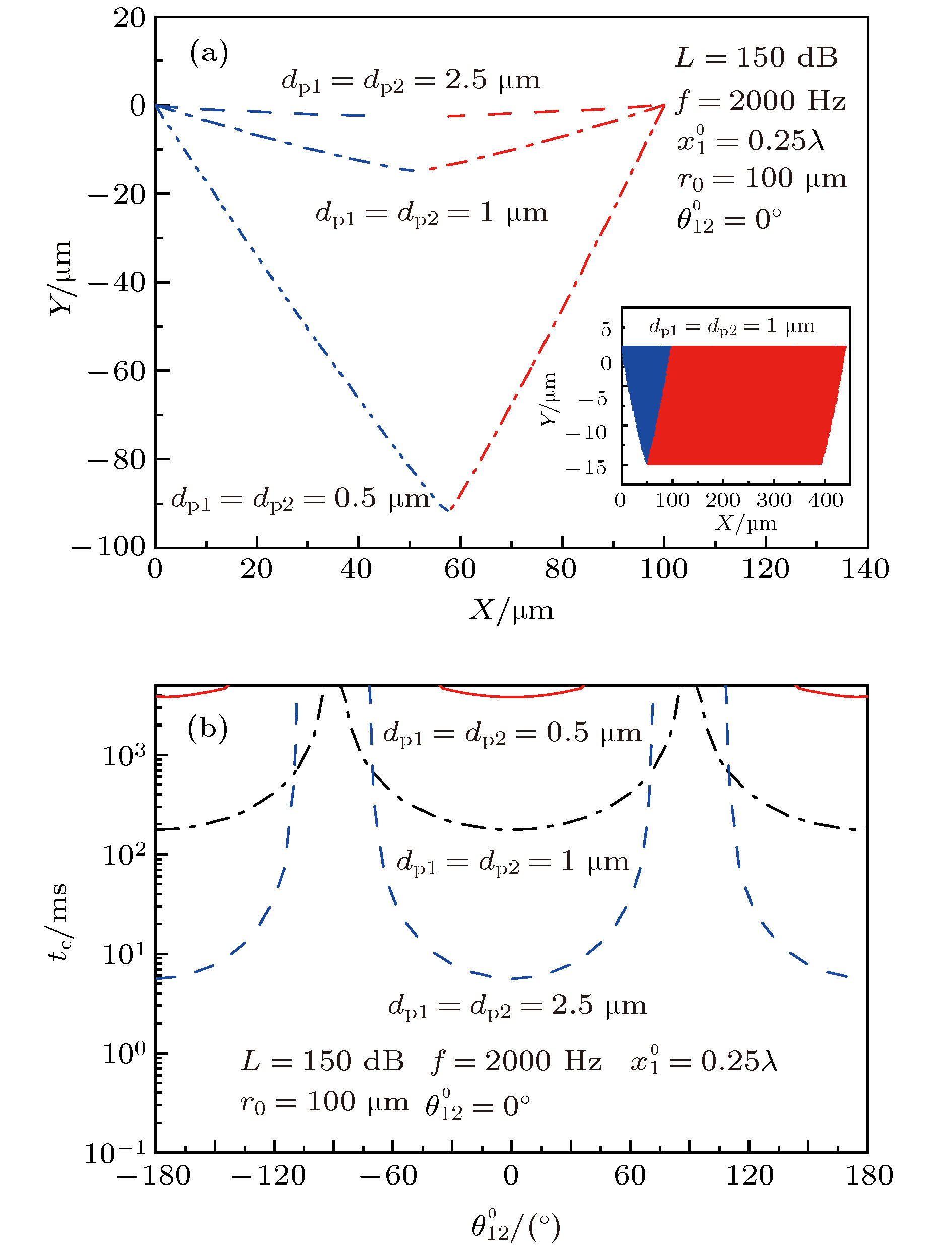-
The external acoustic field can be used to promote the interactions between fine particles suspended in the gas phase. Due to the particle interaction, collision and agglomeration between fine particles occur, causing the average particle size to increase and the particle number concentration to decrease. This offers an important technical route to controlling the emissions of fine particles. However, the interaction behaviors between the fine particles under the acoustic field are still not well understood, which severely hinders the technology from developing for fine particle emission control by using acoustic agglomeration. In order to reveal the interaction between monodisperse fine particles in a standing wave acoustic field, a particle interaction model with consideration of the drag force, gravity and acoustic wake effect is developed. The particle motion equations in the model are solved by using the classical Runge-Kutta method combined with the second-order implicit Adams interpolation method. The particle velocity due to acoustic entrainment and the interaction process between particles obtained from the numerical simulation are compared with the corresponding analytical solutions and experimental results to validate the accuracy of model prediction. Good agreement is found, which indicates that the model and the numerical method are capable of accurately predicting the interaction between fine particles in the standing wave acoustic field. On this basis, the effects of initial conditions and diameters of particles on the interaction behaviors are explored. The results show that when the initial particle centerline is closer to the acoustic wave direction or the initial particle position is closer to the wave antinode, the acoustic wake effect between the particles becomes stronger, and shorter time is required for particles to collide. It is also found that the influence of particle diameter on particle interaction depends on the initial deviation of particle centerline from the acoustic wave direction. When the deviation is small, the larger the particle diameter, the shorter the time required for particles to collide is. When the deviation is large, the collision between particles with smaller diameters occurs, while the collision between particles with larger diameters may not occur.
-
Keywords:
- fine particles /
- particle interaction /
- standing wave /
- acoustic field
[1] Lu M S, Fang M X, He M C, Liu S X, Luo Z Y 2019 RSC Adv. 9 5224
 Google Scholar
Google Scholar
[2] Shen G Q, Huang X Y, He C L, Zhang S P, An L S 2018 Powder Technol. 325 145
 Google Scholar
Google Scholar
[3] Fan F X, Zhang M J, Peng Z B, Chen J, Su M X, Moghtaderi B, Doroodchi E 2017 Aerosol Air Qual. Res. 17 1073
 Google Scholar
Google Scholar
[4] Parimanan C, Sattawat C, Pattanaporn L 2018 Powder Technol. 340 243
 Google Scholar
Google Scholar
[5] Herrera C A, Levy E K, Ochs J 2002 AIChE J. 48 503
 Google Scholar
Google Scholar
[6] Francisco J T, Sebastian E, Dirk M, Jurg D, Kai K 2013 Ultrason. Sonochem. 20 655
 Google Scholar
Google Scholar
[7] Kooij S, Astefanei A, Corthals G L, Bonn D 2019 Sci. Rep. 9 6128
 Google Scholar
Google Scholar
[8] An Z S, Huang R J, Zhang R Y, Tie X X, Li G H, Cao J J, Zhou W J, Shi Z G, Han Y M, Gu Z L, Ji Y M 2019 PNAS 116 8657
 Google Scholar
Google Scholar
[9] Jiang X D, Xu H, Wang X 2014 Chin. Phys. B 23 125201
 Google Scholar
Google Scholar
[10] Fan F X, Zhang S H, Wang W Y Yan J P, Su M X 2019 Process Saf. Environ. Prot. 125 197
 Google Scholar
Google Scholar
[11] Fan F X, Zhang S H, Peng Z B, Chen J, Su M X, Moghtaderi B, Doroodchi E 2019 Can. J. Chem. Eng. 97 930
 Google Scholar
Google Scholar
[12] Amiri M, Sadighzadeh A, Falamaki C 2016 Aerosol Air Qual. Res. 16 3012
 Google Scholar
Google Scholar
[13] Qiao Z H, Dong W, Huang Y J, Naso V 2018 J. Environ. Sci. 67 161
 Google Scholar
Google Scholar
[14] Zhang G X, Zhou T T, Zhang L L, Wang J Q, Chi Z H, Hu E 2018 Chem. Eng. J. 334 891
 Google Scholar
Google Scholar
[15] González I, Gallego J A, Riera E 2003 J. Aerosol Sci. 34 1611
 Google Scholar
Google Scholar
[16] Zhang G X, Liu J Z, Wang J, Zhou J H, Cen K F 2012 Chin. Sci. Bull. 57 2404
 Google Scholar
Google Scholar
[17] Fan F X, Yang X F, Kim C N 2013 J. Mech. Sci. Technol. 27 1707
 Google Scholar
Google Scholar
[18] Maknickas A, Markauska D, Kačianauskas R 2016 Part. Sci. Technol. 34 453
 Google Scholar
Google Scholar
[19] Fan F X, Xu X, Zhang S H, Su M X 2019 Aerosol Sci. Technol. 53 1204
 Google Scholar
Google Scholar
[20] Li S Q, Marshall J S, Liu G Q, Yao Q 2011 Prog. Energ. Combust. 37 633
 Google Scholar
Google Scholar
[21] Crowe C T, Schwarzkopf J D, Scommerfeld M, Tsuij Y 2012 Multiphase Flows with Droplets and Particles (2nd Ed.) (New York: CRC Press) pp67−72
[22] González I, Elvira L, Hoffmann T L, Gallego J A 2001 Acta Acust. Acust. 87 454
[23] González I, Hoffmann T L, Gallego J A 2000 Acta Acust. Acust. 86 784
[24] Li S Q, Marshall J S 2007 J. Aerosol Sci. 38 1031
 Google Scholar
Google Scholar
[25] Zhang G X, Zhang L L, Wang J Q, Chi Z H, Hu E 2018 Powder Technol. 323 393
 Google Scholar
Google Scholar
[26] Yan J P, Chen L Q, Yang L J 2016 Chem. Eng. J. 290 319
 Google Scholar
Google Scholar
[27] Zhang G X, Ma Z F, Shen J, Zhang K, Wang J Q, Chi Z H 2020 J. Hazard. Mater. 382 121089
 Google Scholar
Google Scholar
-
图 4 初始夹角对颗粒相互作用特性的影响 (a)颗粒相互作用趋势, 内插图为
$\theta _{12}^0$ = 40°时颗粒的运动轨迹; (b)碰撞时间Figure 4. Influence of initial orientation angle on particle interaction: (a) Trend of particle interaction, inset shows particle trajectories at
$\theta _{12}^0$ = 40°; (b) time required for the particles to achieve collision.图 5 初始位置对颗粒相互作用特性的影响 (a)颗粒相互作用趋势, 内插图为
$x_1^0$ = 0.375λ时颗粒的运动轨迹; (b)碰撞时间Figure 5. Influence of initial particle position (
$x_1^0$ ) on particle interaction: (a) Trend of particle interaction, inset shows particle trajectories at$x_1^0$ = 0.375λ; (b) time required for the particles to achieve collision. -
[1] Lu M S, Fang M X, He M C, Liu S X, Luo Z Y 2019 RSC Adv. 9 5224
 Google Scholar
Google Scholar
[2] Shen G Q, Huang X Y, He C L, Zhang S P, An L S 2018 Powder Technol. 325 145
 Google Scholar
Google Scholar
[3] Fan F X, Zhang M J, Peng Z B, Chen J, Su M X, Moghtaderi B, Doroodchi E 2017 Aerosol Air Qual. Res. 17 1073
 Google Scholar
Google Scholar
[4] Parimanan C, Sattawat C, Pattanaporn L 2018 Powder Technol. 340 243
 Google Scholar
Google Scholar
[5] Herrera C A, Levy E K, Ochs J 2002 AIChE J. 48 503
 Google Scholar
Google Scholar
[6] Francisco J T, Sebastian E, Dirk M, Jurg D, Kai K 2013 Ultrason. Sonochem. 20 655
 Google Scholar
Google Scholar
[7] Kooij S, Astefanei A, Corthals G L, Bonn D 2019 Sci. Rep. 9 6128
 Google Scholar
Google Scholar
[8] An Z S, Huang R J, Zhang R Y, Tie X X, Li G H, Cao J J, Zhou W J, Shi Z G, Han Y M, Gu Z L, Ji Y M 2019 PNAS 116 8657
 Google Scholar
Google Scholar
[9] Jiang X D, Xu H, Wang X 2014 Chin. Phys. B 23 125201
 Google Scholar
Google Scholar
[10] Fan F X, Zhang S H, Wang W Y Yan J P, Su M X 2019 Process Saf. Environ. Prot. 125 197
 Google Scholar
Google Scholar
[11] Fan F X, Zhang S H, Peng Z B, Chen J, Su M X, Moghtaderi B, Doroodchi E 2019 Can. J. Chem. Eng. 97 930
 Google Scholar
Google Scholar
[12] Amiri M, Sadighzadeh A, Falamaki C 2016 Aerosol Air Qual. Res. 16 3012
 Google Scholar
Google Scholar
[13] Qiao Z H, Dong W, Huang Y J, Naso V 2018 J. Environ. Sci. 67 161
 Google Scholar
Google Scholar
[14] Zhang G X, Zhou T T, Zhang L L, Wang J Q, Chi Z H, Hu E 2018 Chem. Eng. J. 334 891
 Google Scholar
Google Scholar
[15] González I, Gallego J A, Riera E 2003 J. Aerosol Sci. 34 1611
 Google Scholar
Google Scholar
[16] Zhang G X, Liu J Z, Wang J, Zhou J H, Cen K F 2012 Chin. Sci. Bull. 57 2404
 Google Scholar
Google Scholar
[17] Fan F X, Yang X F, Kim C N 2013 J. Mech. Sci. Technol. 27 1707
 Google Scholar
Google Scholar
[18] Maknickas A, Markauska D, Kačianauskas R 2016 Part. Sci. Technol. 34 453
 Google Scholar
Google Scholar
[19] Fan F X, Xu X, Zhang S H, Su M X 2019 Aerosol Sci. Technol. 53 1204
 Google Scholar
Google Scholar
[20] Li S Q, Marshall J S, Liu G Q, Yao Q 2011 Prog. Energ. Combust. 37 633
 Google Scholar
Google Scholar
[21] Crowe C T, Schwarzkopf J D, Scommerfeld M, Tsuij Y 2012 Multiphase Flows with Droplets and Particles (2nd Ed.) (New York: CRC Press) pp67−72
[22] González I, Elvira L, Hoffmann T L, Gallego J A 2001 Acta Acust. Acust. 87 454
[23] González I, Hoffmann T L, Gallego J A 2000 Acta Acust. Acust. 86 784
[24] Li S Q, Marshall J S 2007 J. Aerosol Sci. 38 1031
 Google Scholar
Google Scholar
[25] Zhang G X, Zhang L L, Wang J Q, Chi Z H, Hu E 2018 Powder Technol. 323 393
 Google Scholar
Google Scholar
[26] Yan J P, Chen L Q, Yang L J 2016 Chem. Eng. J. 290 319
 Google Scholar
Google Scholar
[27] Zhang G X, Ma Z F, Shen J, Zhang K, Wang J Q, Chi Z H 2020 J. Hazard. Mater. 382 121089
 Google Scholar
Google Scholar
Catalog
Metrics
- Abstract views: 9880
- PDF Downloads: 125
- Cited By: 0















 DownLoad:
DownLoad:










